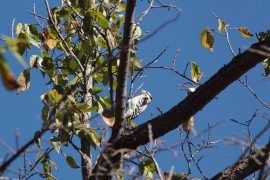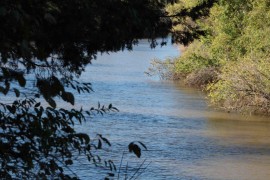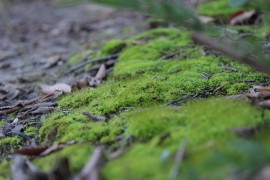Oil or Turtles: Habitat Fragmentation Threatens State Wildlife

Land development is creating hundreds of orphans each year in Oklahoma – orphan animals that are losing their homes.
“Humans are the primary reason most of them are here.” said Nicole Rivera, a volunteer at Wildcare in Noble Oklahoma and an ecology student at the University of Oklahoma.
Wildcare takes in injured wildlife and nurses them back to health and prepares them for re-release into the wild.
“We get animals that are hit by cars while trying to cross roads that run through their natural habitat or when a plot of land is bulldozed and nests are found in knocked down trees,” she said.
Wildcare often takes in orphaned baby animals like possums, which play a crucial part in the ecosystem by controlling pests’ populations.

This issue extends beyond Noble. Johnson Bridgewater, the Director of the Oklahoma Chapter of The Sierra Club said the increase in orphan animals is part of the lasting effects from energy production in Oklahoma.
“We can say aquatic species are impacted by wastewater injection,” he said. “In northern Oklahoma the Ponca City area has suffered massive fish kills that have been linked to wastewater injection (such as) Bird Creek in Tulsa.”
Bridgewater said the Oklahoma Department of Environmental Quality has a list of 54 different lakes with dangerous levels of Mercury.
The ODEQ website said Mercury, an element, is released to the atmosphere through man-made (mining, manufacturing processes, coal-fired utilities, or industries) or natural
processes (volcanoes or weathering of rocks).”
Mercury, the DEQ said, attaches to dust particles and is then washed into rivers and streams by rain or melting snow. While moving through the environment the Mercury changes into Methyl Mercury which enters the food chain through predatory fish like bass and catfish.
Bridgewater said that habitat fragmentation is a more general threat to Oklahoma wildlife. Habitat fragmentation is defined as “the process by which habitat loss results in the division of large, continuous habitats into smaller, more isolated remnants.”
“If an oil well is put into production the company will bring in equipment to keep the site producing which requires them to square off land to allow trucks to come in, transport the oil and allow people to keep the pump in working condition,” he said.
These oil operations are sometimes set up on government owned land that is part of our national parks system. The Arctic National Wildlife Refuge at the tip of Alaska is one such area the state and federal lawmakers have looked at as a option to help America’s energy independence.
Wade Schock is a biologist with Alaskan Fish and Game. Schock said, “It’s been talked about for a long time, its controversial issue there are many people on both sides. The [oil] industry is pushing hard to make that happen, and in some ways the state supports that due to the revenue it would bring in, there are also environmental groups that would want to not allow drilling in the arctic.”
The National Wildlife Refuge Association, a non-profit organization that tries to prevent the disruption of America’s wildlife refuges, continues to push back against the oil and gas industry.
“What was deemed an illegal request in 2014 is still an illegal request regardless of if it is being made by the state or the department itself,” Geoffery Haskett, president of NWRA, said in a press release.
Hasskett said he believes what the Alaskan government and the Department of the Interior are asking Alaskans to do is illegal.
“The Arctic Refuge must be protected from those who seek its permanent destruction for short-term financial gain,” he said
Schock said drilling that has happened in Alaska so far has disputed some of the migration paths of herd animals he was unsure of the lasting impact that drilling in Alaska will have.
“There is no question that is will have an impact on the eco system up there but to what degree that is probably depends on who you ask. Environmental agencies would say it’s going to be horrific and change the eco systems up there. The oil industry and others that want to drill would say the impact will be minimal and the benefits would be worth it, the truth lies somewhere in the middle,” he said.

The energy production in areas like this helps to pay for state fish and wildlife services.
A Institute of Energy Research study in 2016 stated that oil production on federal land made up 36 percent of the industry’s total in 2010 but dropped to just 21 percent by 2015.
For the foreseeable future fossil fuels are a necessity to maintain day to day operation in the United States. Energy production will always make some impact on the environment.
The Nature Conservancy in Oklahoma is working on ways the minimize that impact.
Katie Hawk, Director of Communications and External Affairs at the organization, is working to keep habitat fragmentation to a minimum in Oklahoma.
“The biggest issue for us is wind farm development. We have developed an online wind mapping tool that allows wind developers or anyone to go online and site the area they are looking at (for wind farm development) and determine if the area is a migration path or wildlife habitat.” she said
Hawk said the organization worked to develop different types of provisions to protect the area. In the case of a spill or any type of mishap Hawk said cleanup is handled effectively and “within our realm of conservation.”
The Oklahoma Energy Resources Board is voluntarily funded by the oil and natural gas industries in Oklahoma. The industry donates about 1 percent of the sales of oil and natural gas to fund OERB.
The organization is working to clean up abandoned well sites by removing equipment and closing open wells along with repairing erosion and saltwater “scars.”
The OERB’s website said the organization has donated $35 million dollars to investigate any links between the increased seismic activity in Oklahoma and fracking.
Mike Paque Executive Director of Groundwater Protection Council said underground injection and the disposal of waste water is a very old process and very, very controlled.
“Education is incurably important, we are a form of one on one education, teaching how each individual is important as part of the ecosystem.” Rivera said.
She said the public needs to understand the value of individuals.
“The need for a balance between conservation and energy is something we desperately need,” Rivera said. “While Wildcare does its best to educate the public, the state should make more of an effort to educate the public. “Human nature is a little selfish and people usually disregard natural habitats for animals.”
